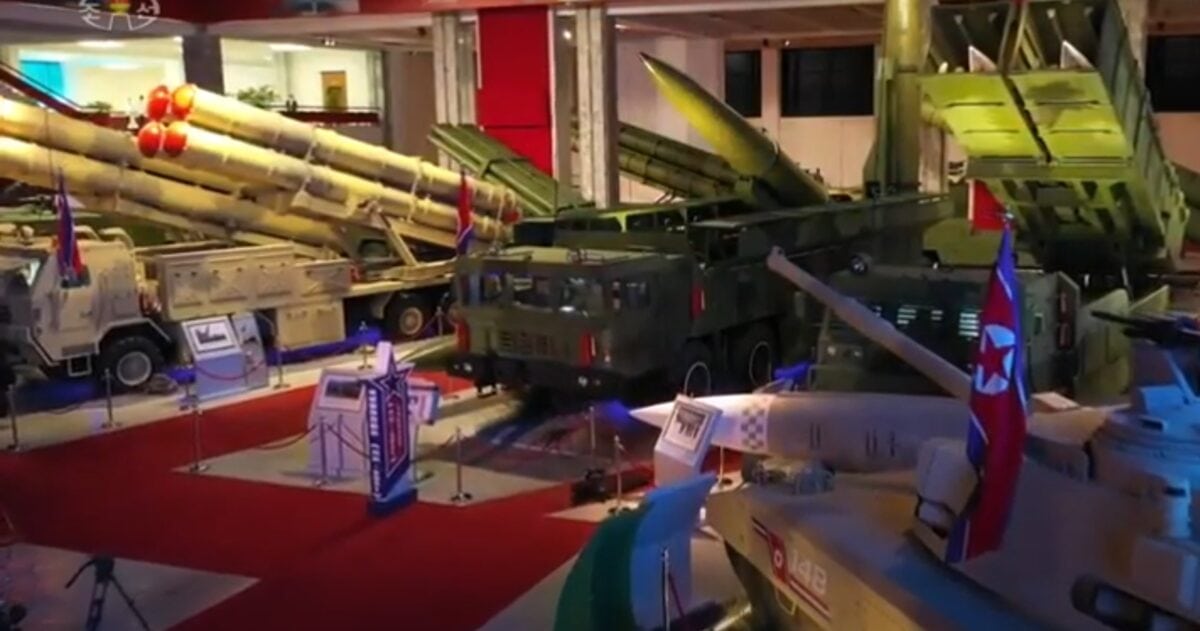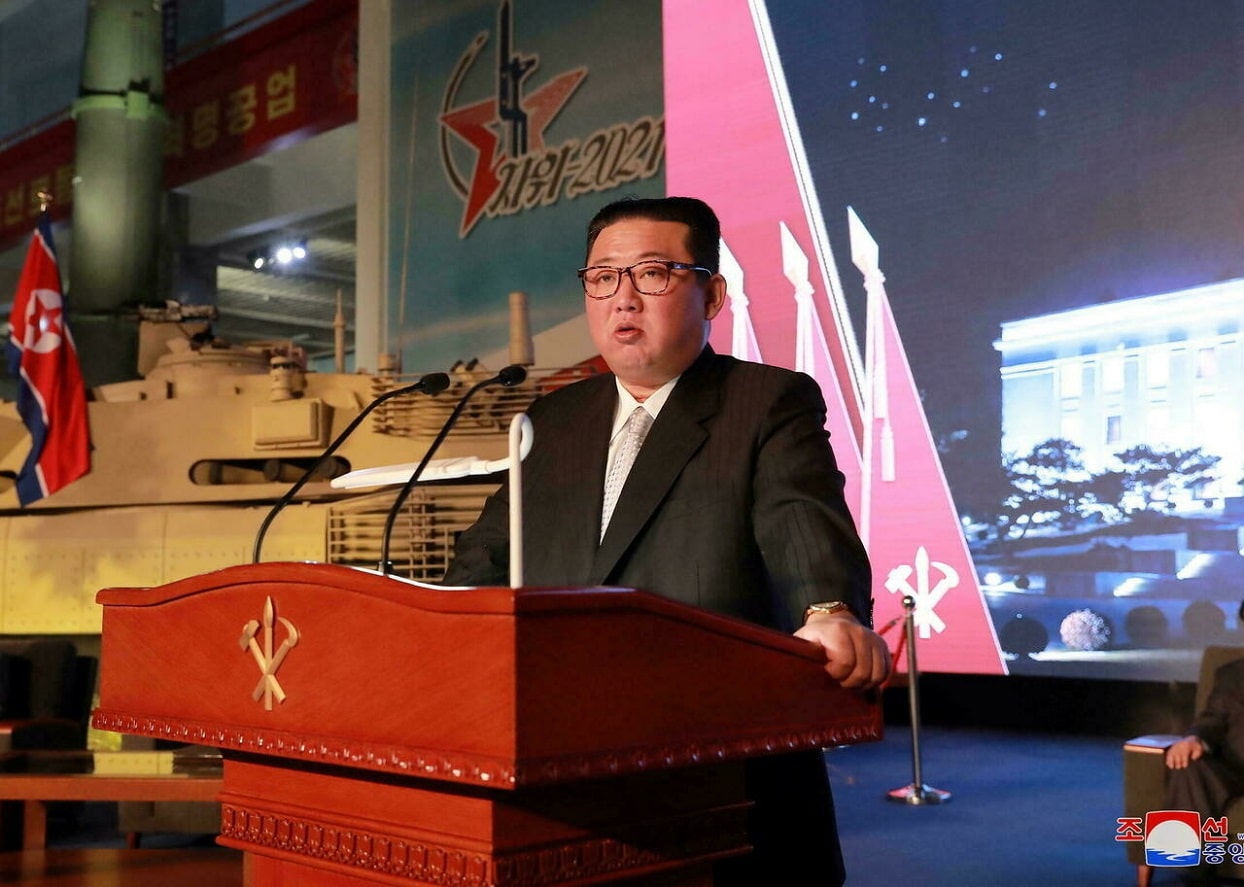North Korea is pushing ahead with a new, ambitious period of military modernization. To succeed, Kim Jong-un will depend on the research and development expertise of his munitions industry. On October 12, Kim attended the opening of a new Defense Development Exhibition, days after the 76th founding anniversary of North Korea’s ruling Workers’ Party.
The North Korea’s missile exhibition featured many of Pyongyang’s “greatest hits,” including the KN28 super-heavy untested ICBM (also known as the Hwasong-16), which was first seen at a parade in October 2020, and the Hwasong-15, the largest tested North Korean ICBM. Many more recently tested systems were also on display, including the new Hwasong-8 hypersonic glide vehicle and a model rail-mobile missile launcher. Pyongyang’s new long-range cruise missile was shown off as well.
North Korea’s Missile Exhibition: Why Do It?
This exhibition is without precedent and, according to North Korean state media, was designed to celebrate the “do-or-die spirit” of the country’s defense industry. It focused on the greatest accomplishments of the last five years. As a result, Kim walked around and surveyed a range of nuclear-capable missile systems, short-range conventional missiles, surface-to-air missiles, and more.
An important theme of Kim Jong-un’s leadership tenure has been the centering and elevation of national defense scientists. In 2017, after North Korea’s first and second successful tests of the Hwasong-14 intercontinental-range ballistic missiles, the scientists and technicians involved in realizing those accomplishments were bussed to Pyongyang for a celebratory concert with Kim himself.
At other times, Kim has been seen embracing and laughing with senior technical experts after successful missile tests. These images are broadcast throughout North Korea and emphasize the country’s public the central role of the national scientific talent base. In 2019, Kim even underscored that a missile system newly tested that year was developed by a younger generation of engineers who represented the next-generation of North Korean talent in weapons design.
Overwhelmingly, this same rationale undergirds the internal propaganda rationale behind this latest exhibition. At a time when Kim has been open about North Korea’s internal economic difficulties amid its self-imposed pandemic lockdown, he’s careful to indicate that his leadership continues to ensure that North Korea’s self-reliant national defense base continues to flourish. The recent spate of new missile tests in September 2021 further underscored this in practice.
North Korea’s Missile Exhibition: The New Military Parade?
Kim compared the significance of the exhibition to that of a military parade: “the grand exhibition today … also becomes a striking manifestation of the state power as important as a large-scale military parade,” Kim said, according to a state media paraphrase of his remarks. Parades are less rare than they used to be in North Korea, with iterations in October 2020, January 2021, and September 2021.

Image: KCNA Screenshot.
But parades are logistically complex and spending fuel for parade training and execution may not be ideal. Instead, this exhibition serves similar internal and external propaganda purposes. A further consideration may be what this exhibition permits in terms of signaling to the United States.
In 2017, while Kim did oversee the testing of North Korea’s first ICBMs, he saw North Korea sanctioned repeatedly by the United Nations Security Council. China and Russia, notably, did not obstruct action against Pyongyang at the time. Today, China and Russia are more openly favorable toward sanctions relief for North Korea, but this position might become less tenable should North Korea return to testing ICBMs.
Even as Kim has outlined plans for new ICBMs, including ICBMs capable of carrying multiple warheads, he may not be in a rush to test them just yet. Instead, parades and exhibitions serve as an important opportunity to show off these capabilities to the outside world, including the United States. These events, while less sensational than the missile tests of 2017, capture attention and elevate North Korea’s relevance in the foreign policy debate in the United States.
Interestingly, in his remarks, Kim underemphasized the role of South Korea in North Korea’s ongoing military modernization. He instead pointed to the United States as the source of “tension” on the Korean Peninsula, implying that North Korea’s full court press on nuclear modernization is solely directed at Washington. The lack of emphasis on South Korea is consistent with ongoing North Korean efforts to pursue rapprochement with Seoul ahead of next year’s presidential elections (with hopes of tipping the scales somewhat in favor of South Korea’s pro-engagement progressives).
For policymakers in the U.S., this exhibition should serve as a wake-up call: North Korea is fully embarked on a new five-year plan, which includes a set of well-defined milestones for qualitative nuclear force modernization. Kim Jong Un delineated his expectations back in January, at the 8th Party Congress, and his celebration of the country’s defense-industrial base marks a return to the themes that were pervasive throughout the rapid advancements seen in 2016 and 2017.
What Signal to Washington?
North Korea continues to be dissatisfied with the Biden administration’s approach toward diplomacy and instead seeks to create sufficient incentives for the United States to agree to explicit discussions on sanctions relief. While the administration’s offer of open-ended exploratory talks without conditions is less stringent than previous U.S. introductory offers, it appears to be insufficient for Pyongyang. In this environment, Kim hopes that repeated reminders of what Pyongyang has accomplished, can accomplish, and may soon accomplish with regards to its nuclear forces can change Washington’s calculus.
Ankit Panda is the Stanton Senior Fellow in the Nuclear Policy Program at the Carnegie Endowment for International Peace in Washington, DC. He is also the author of ‘Kim Jong Un and the Bomb: Survival and Deterrence in North Korea’ (Hurst/Oxford, 2020).

